The Performance Analysis of Grouting Repair Effect on the Accuracy of Disturbance Stress Test in Damaged Surrounding Rock Mass
Abstract
:1. Introduction
2. Disturbance Stress Simulation Test in Damaged Hard Rock
2.1. Numerical Models and Simulation Procedures
- (a)
- Model establishment: The model is created, and the material parameters and initial stress conditions of the surrounding rock are assigned.
- (b)
- Borehole drilling: A borehole is drilled to the depth of y = 1.5 m, indicating that the drilling has reached the desired testing position.
- (c)
- Sensor installation: The displacement and velocity of the model are reset to zero, representing the initial state of the sensor upon installation into the borehole.
- (d)
- Grouting body activation: The grouting body at y = 1.0–1.5 m is activated, and the material parameters for the grouting body are assigned.
- (e)
- Loading disturbance stress: Disturbance stress conditions are applied at the boundaries of the model, and the equilibrium is solved.
- (f)
- Stress calculation: The strain at the monitoring point is extracted, and the stress is calculated using the stress calculation method in the next section.
2.2. Disturbance Stress Simulation Test Method
3. Influence of Grouting Repair on Disturbance Stress Test Accuracy
3.1. Borehole Damage Distribution under Initial Stress and Disturbance Stress
3.2. Disturbance Stress Test Error under Different Borehole Damage Conditions
3.3. Influence of Grouting Repair on the Disturbance Stress Test Accuracy
4. Discussion
4.1. Analysis of Disturbance Stress in a Circular Opening
4.2. SST Method for Disturbance Stress Testing under High-Stress Environments
4.3. The Effect of SST Perturbation Stress Measurement Method
5. Conclusions
- (1)
- Excavation or drilling in deep, high-stress environments can result in rock damage, which affects the accuracy of disturbance stress testing using the stress relief method. The testing error increases with the depth of the damaged zone.
- (2)
- The repair effect of grouting on the surrounding rock will help improve the accuracy of stress testing, and the error of stress testing will decrease with the increase in repair depth.
- (3)
- Taking into account the restorative properties of grouting in rock formations, a segmented testing approach for disturbance stress is introduced. This method entails conducting separate tests to measure the initial stress and stress changes, effectively lowering the internal stress levels within the rock. By reducing the extent of rock damage, this approach enhances the precision of disturbance stress testing.
- (4)
- During the practical implementation of disturbance stress testing, it is recommended to utilize high-strength and well-repaired grouting materials. This serves a dual purpose: firstly, it facilitates the repair of initial damage within the borehole; secondly, it safeguards the grouting body against damage within the disturbance stress environment. By adhering to these guidelines, the reliability of stress testing results can be significantly enhanced.
Author Contributions
Funding
Institutional Review Board Statement
Informed Consent Statement
Data Availability Statement
Conflicts of Interest
References
- Kaiser, P.K.; Yazici, S.; Maloney, S. Mining-induced stress change and consequences of stress path on excavation stability—A case study. Int. J. Rock Mech. Min. Sci. 2001, 38, 167–180. [Google Scholar] [CrossRef]
- Zhang, C.; Feng, X.T.; Hui, Z. Estimation of in situ stress along deep tunnels buried in complex geological conditions. Int. J. Rock Mech. Min. Sci. 2012, 52, 139–162. [Google Scholar] [CrossRef]
- Fairhurst, C. Stress estimation in rock: A brief history and review. Int. J. Rock Mech. Min. Sci. 2003, 40, 957–973. [Google Scholar] [CrossRef]
- Eberhardt, M. Damage initiation and propagation in hard rock during tunnelling and the influence of near-face stress rotation. Int. J. Rock Mech. Min. Sci. 2004, 41, 785–812. [Google Scholar]
- Zheng, M.Z.; Li, S.J.; Yao, Z.; Zhang, A.D.; Xu, D.P.; Zhou, J.F. Core discing characteristics and mitigation approach by a novel developed drill bit in deep rocks. J. Cent. South Uni. 2020, 27, 2822–2833. [Google Scholar] [CrossRef]
- Li, S.J.; Feng, X.-T.; Wang, C.Y.; Hudson, J.A. ISRM suggested method for rock fractures observations using a borehole digital optical televiewer. Rock Mech. Rock Eng. 2013, 46, 635–644. [Google Scholar] [CrossRef]
- Dresen, G.; Stanchits, S.; Rybacki, E. Borehole breakout evolution through acoustic emission location analysis. Int. J. Rock Mech. Min. Sci. 2010, 47, 426–435. [Google Scholar] [CrossRef]
- Amadei, B.; Stephansson, O. Rock Stress and Its Measurement; Springer Science and Business Media: New York, NY, USA, 1997. [Google Scholar]
- Zou, D.H. Applied Rock Mechanics and Ground Stability, 2nd ed.; Canamaple Academia Svcs: Halifax, NS, USA, 2020. [Google Scholar]
- Martin, C.D.; Kaiser, P.K.; Christiansson, R. Stress, instability and design of underground excavations. Int. J. Rock Mech. Min. Sci. 2003, 40, 1027–1104. [Google Scholar] [CrossRef]
- Leeman, E.R. The measurement of changes in rock stress due to mining. Mine Quarry Eng. 1959, 25, 300–304. [Google Scholar]
- Hawkes, I.; Hooker, V.E. The vibrating wire stressmeter. Int. J. Rock Mech. Min. Sci. 1976, 13, 16–17. [Google Scholar] [CrossRef]
- Lin, C.; Zou, D. Formulation and verification of 3D in-situ stress estimation based on differential-direction drilling. Int. J. Rock Mech. Min. Sci. 2021, 145, 104833. [Google Scholar] [CrossRef]
- Hudson, J.A.; Cornet, F.H.; Christiansson, R. ISRM suggested methods for rock stress estimation-part 1: Strategy for rock stress estimation. Int. J. Rock Mech. Min. Sci. 2003, 40, 991–998. [Google Scholar] [CrossRef]
- Leeman, E.R. The determination of the complete state of stress in rock in a single borehole-laboratory and underground measurements. Int. J. Rock Mech. Min. Sci. 1968, 5, 31–38. [Google Scholar] [CrossRef]
- Martin, C.D.; Christiansson, R. Overcoring in highly stressed granite—The influence of microcracking. Int. J. Rock Mech. Min. Sci. 1991, 28, 53–70. [Google Scholar] [CrossRef]
- Corthesy, R.; Gill, D.E.; Leite, M.H.; Thompson, P.M. Stress measurements in highstress zones using the modified doorstopper technique. Can. Geotech. J. 1993, 30, 991–1002. [Google Scholar] [CrossRef]
- Yameogo, S.T.; Corthesy, R.; Leite, M.H. Influence of rock failure and damage on in situ stress measurements in brittle rock. Int. J. Rock Mech. Min. Sci. 2013, 61, 118–129. [Google Scholar] [CrossRef]
- Lu, A.Z.; Xu, G.S.; Sun, F.; Sun, W.Q. Elasto-plastic analysis of a circular tunnel including the effect of the axial in situ stress. Int. J. Rock Mech. Min. Sci. 2010, 47, 50–59. [Google Scholar] [CrossRef]
- Wang, S.; Wu, Z.; Guo, M.; Ge, X. Theoretical solutions of a circular tunnel with the influence of axial in situ stress in elastic–brittle–plastic rock. Tunn. Undergr. Sp. Tech. 2012, 30, 155–168. [Google Scholar] [CrossRef]
- Sheng, Q.; Yue, Z.Q.; Lee, C.F.; Tham, L.G.; Zhou, H. Estimating the excavation disturbed zone in the permanent shiplock slopes of the Three Gorges Project, China. Int. J. Rock Mech. Min. Sci. 2002, 39, 165–184. [Google Scholar] [CrossRef]
- Zheng, M.; Li, S.; Xu, H.; Liang, Z.; Lu, X. Investigation of the rock failure effect on overcoring stress relief test in deep hard rock. B. Eng. Geol. Environ. 2023, 82, 353. [Google Scholar] [CrossRef]
- Zheng, M.; Li, S.; Feng, Z.; Liu, L.; Jia, W. Determination of the stress tensor of a triaxial strain cell in a three-layer model using the genetic algorithm and support vector machine. Int. J. Rock Mech. Min. Sci. 2024, 175, 105668. [Google Scholar] [CrossRef]
- Gothall, R.; Stille, H. Fracture dilation during grouting. Tunn. Undergr. Sp. Tech. 2009, 24, 126–135. [Google Scholar] [CrossRef]
- Gustafson, G.; Ciaesson, J.; Asa, F. Steering Parameters for Rock Grouting. J. Appl. Math. 2013, 2013, 1–9. [Google Scholar] [CrossRef]
- Kang, Y.; Liu, Q.; Xi, H.; Gong, G. Improved compound support system for coal mine tunnels in densely faulted zones: A case study of China’s Huainan coal field. Eng. Geol. 2018, 240, 10–20. [Google Scholar] [CrossRef]
- Alejano, L.R.; Rodríguez-Dono, A.; Veiga, M. Plastic radii and longitudinal deformation profiles of tunnels excavated in strain-softening rock masses. Tunn. Undergr. Sp. Tech. 2012, 30, 169–182. [Google Scholar] [CrossRef]
- Sjöberg, J.; Christiansson, R.; Hudson, J.A. ISRM Suggested Methods for rock stress estimation: Part 2: Overcoring methods. Int. J. Rock Mech. Min. Sci. 2003, 40, 999–1010. [Google Scholar] [CrossRef]
- Hajiabdolmajid, V.; Kaiser, P.K.; Martin, C.D. Modelling brittle failure of rock. Int. J. Rock Mech. Min. Sci. 2002, 39, 731–741. [Google Scholar] [CrossRef]
- Ask, D. Measurement-related uncertainties in overcoring data at the Äspö HRL, Sweden. Part 2: Biaxial tests of CSIRO HI overcore samples. Int. J. Rock Mech. Min. Sci. 2006, 43, 127–138. [Google Scholar] [CrossRef]
- Ke, G.; Harrison, J.P. Generation of random stress tensors. Int. J. Rock Mech. Min. Sci. 2017, 94, 18–26. [Google Scholar]
- Fama, M.; Pender, M.J. Analysis of the hollow inclusion technique for measuring in situ rock stress. Int. J. Rock Mech. Min. Sci. 1980, 17, 137–146. [Google Scholar] [CrossRef]
- Labuz, J.F.; Zang, A. Mohr-Coulomb Failure Criterion. Rock Mech. Rock Eng. 2012, 45, 975–979. [Google Scholar] [CrossRef]
- Corthésy, R.; Leite, M.H. A strain-softening numerical model of core discing and damage. Int. J. Rock Mech. Min. Sci. 2008, 45, 329–350. [Google Scholar] [CrossRef]


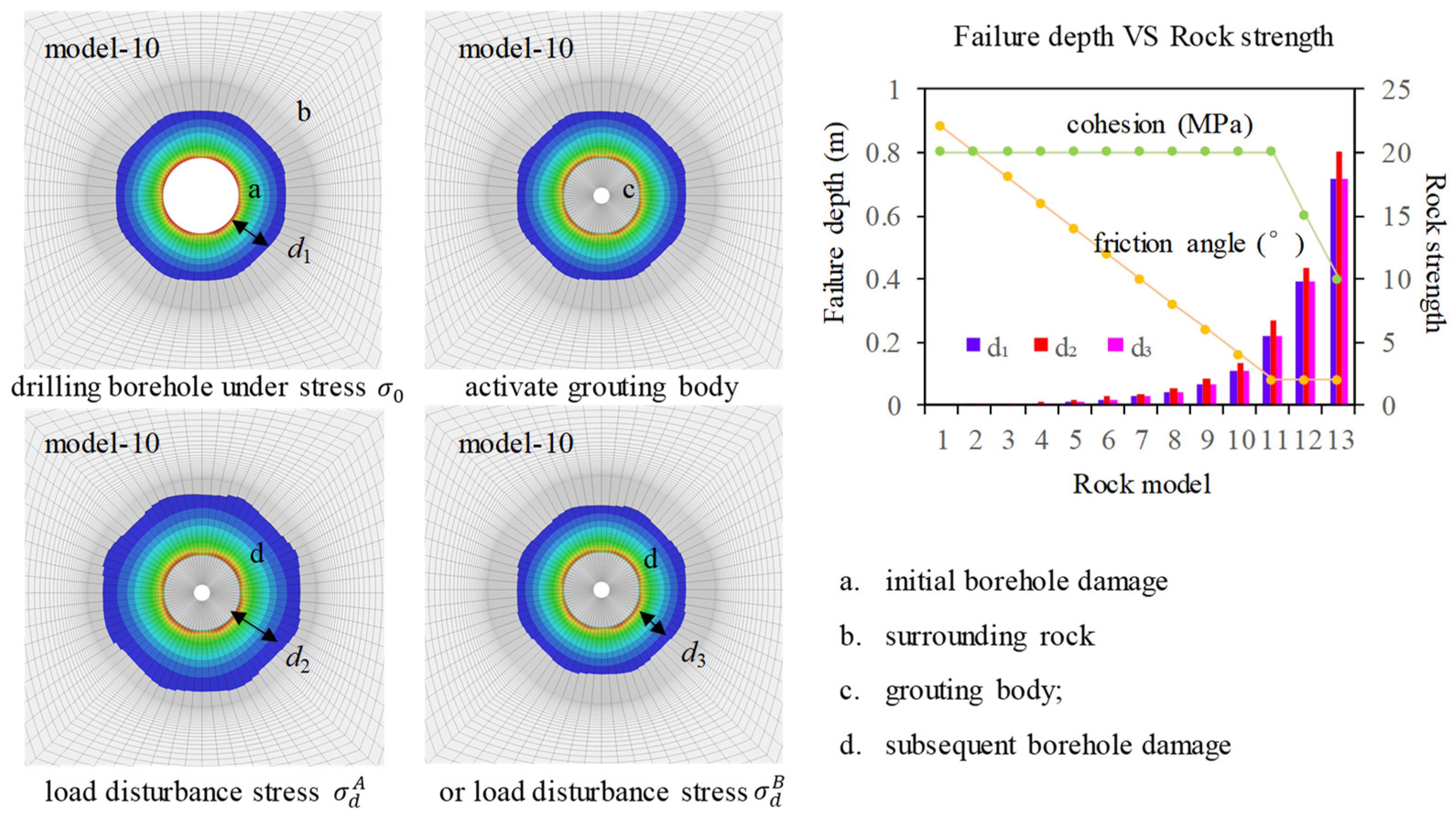
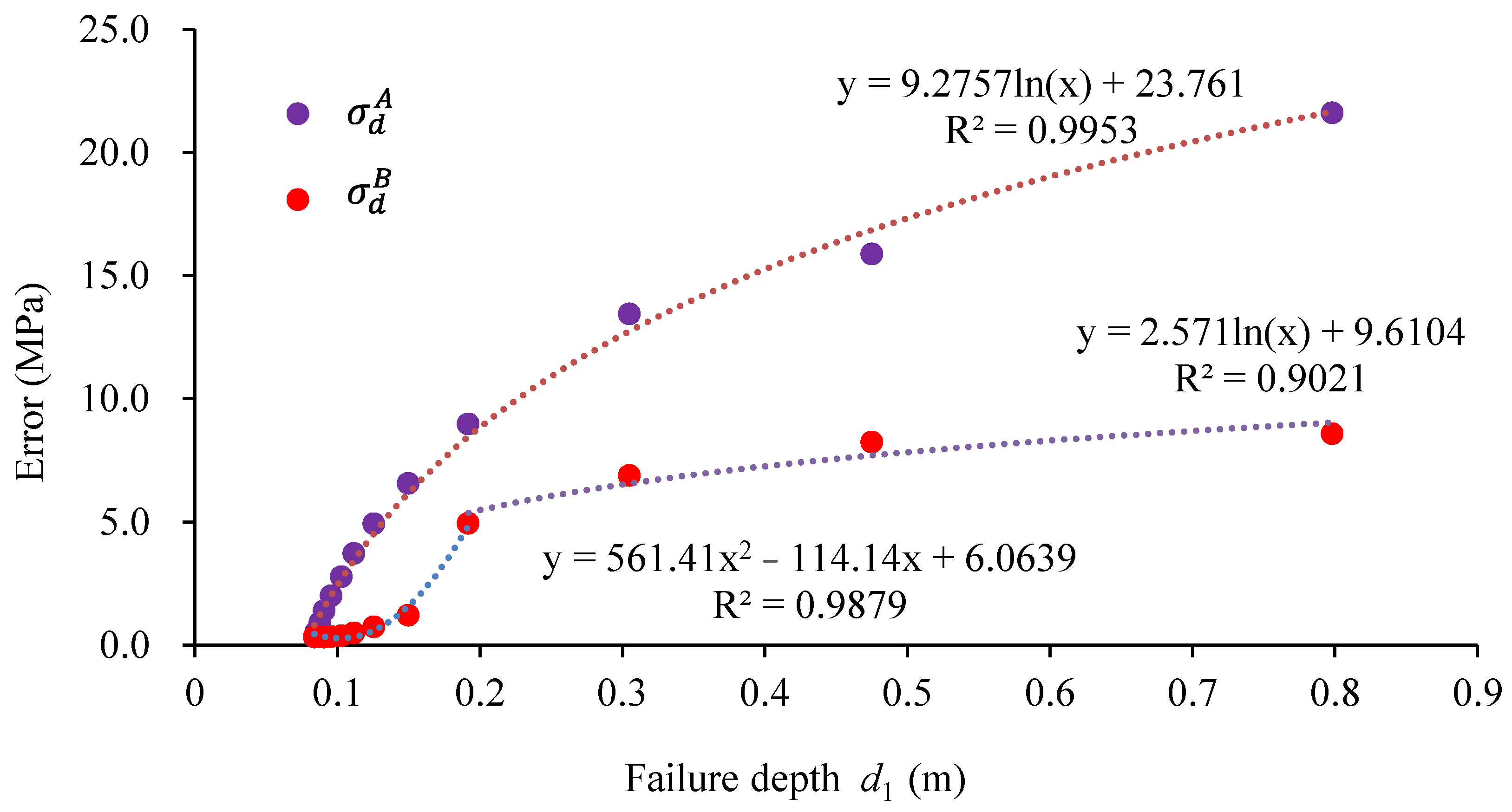
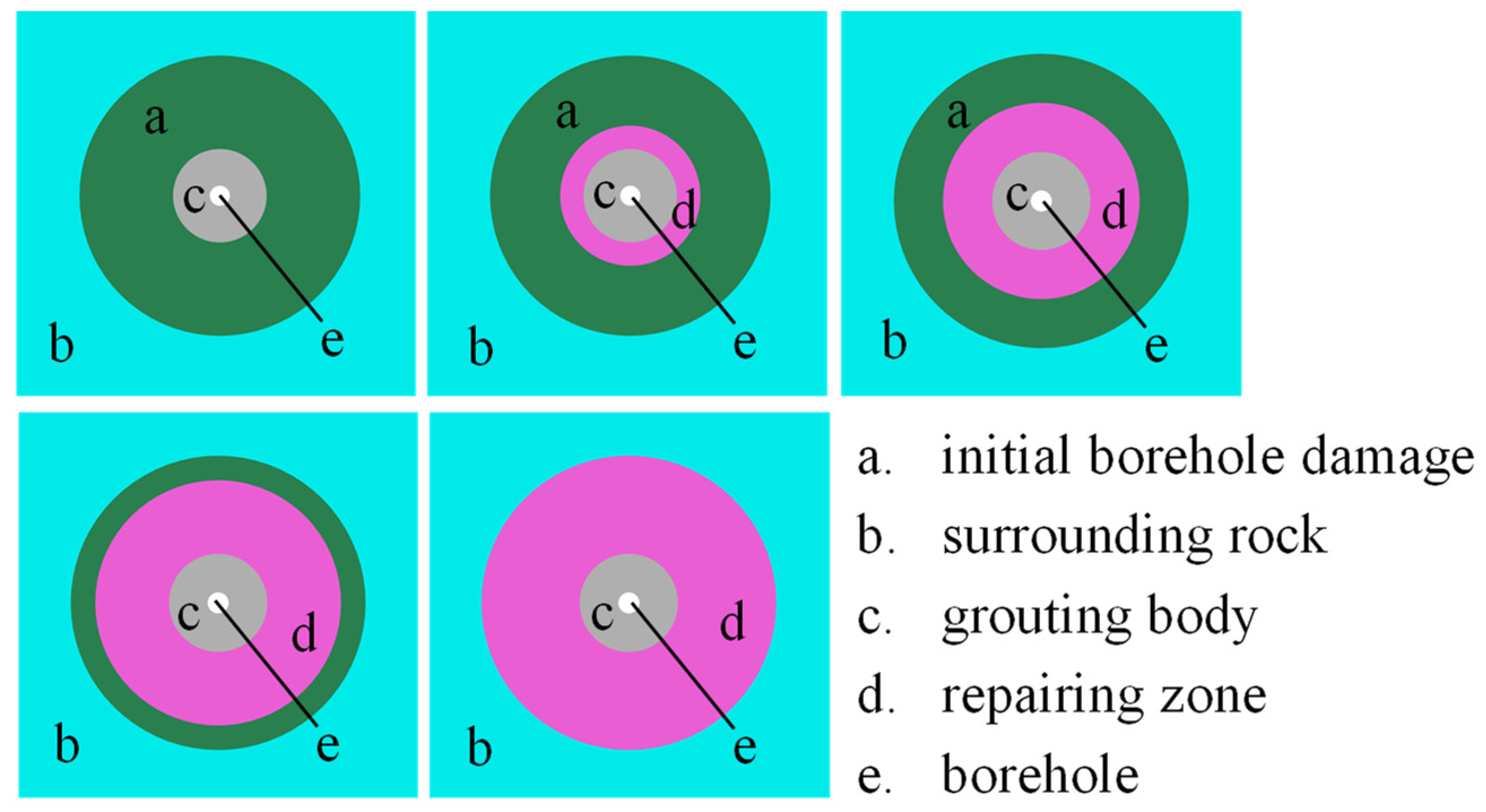
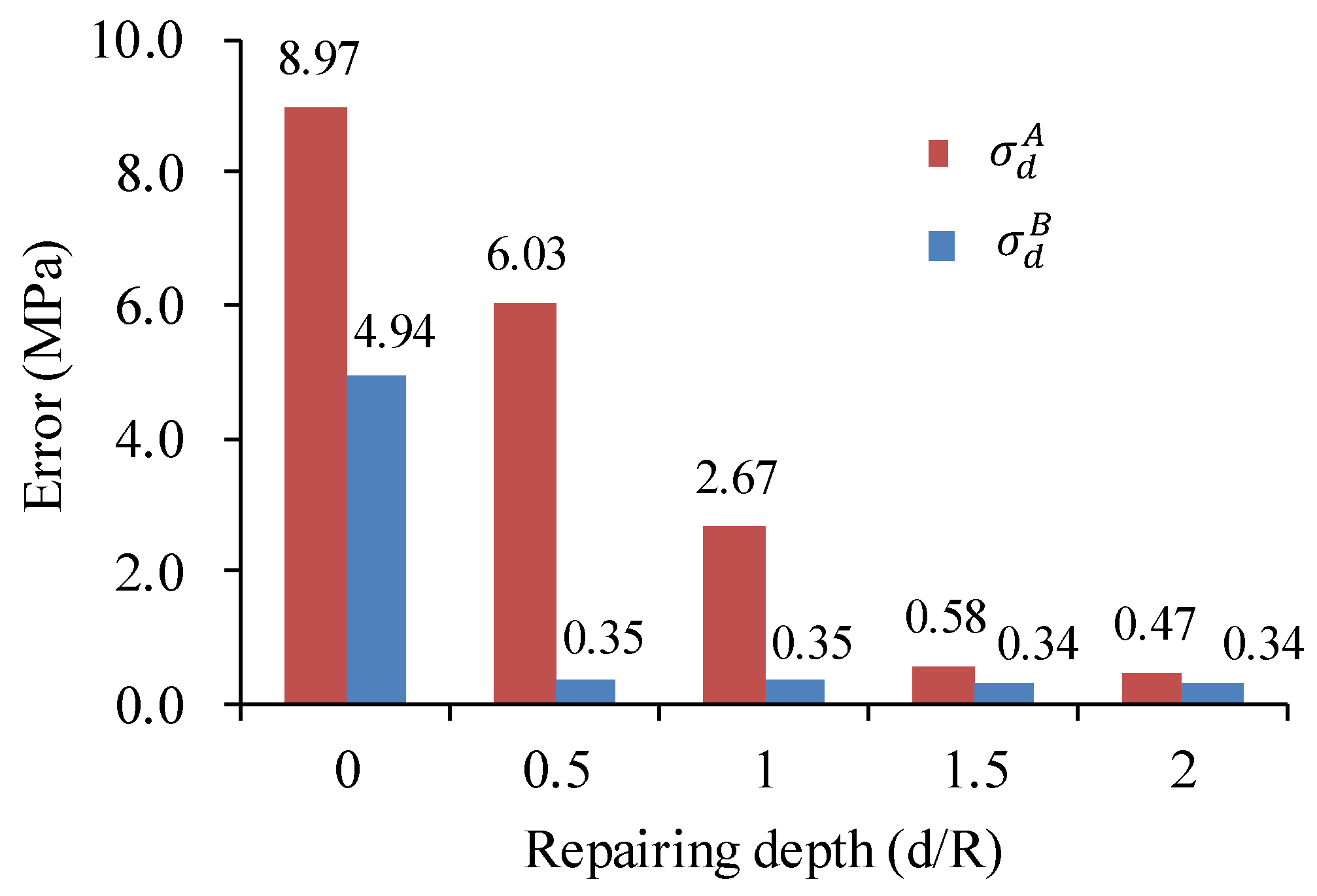
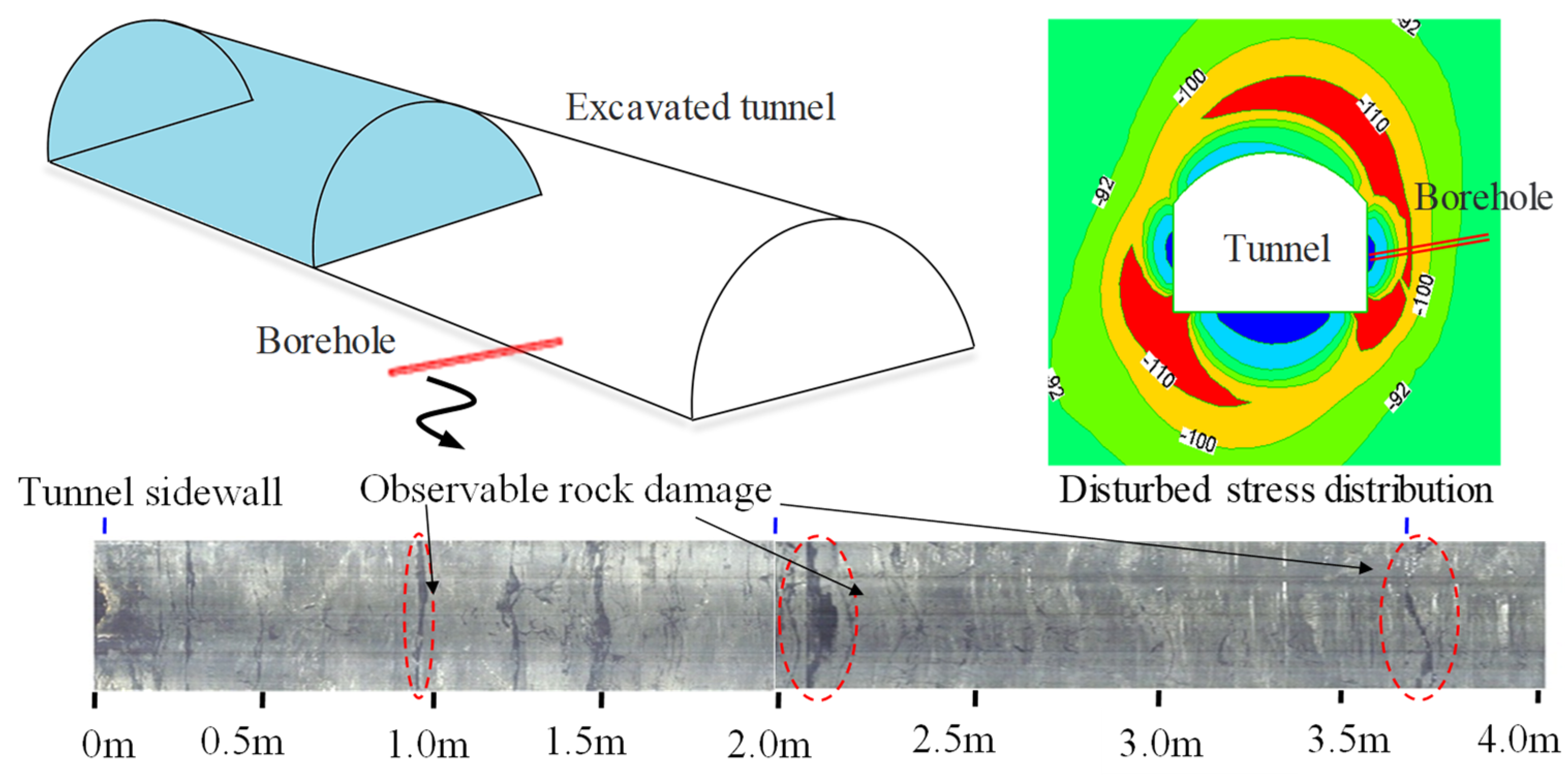
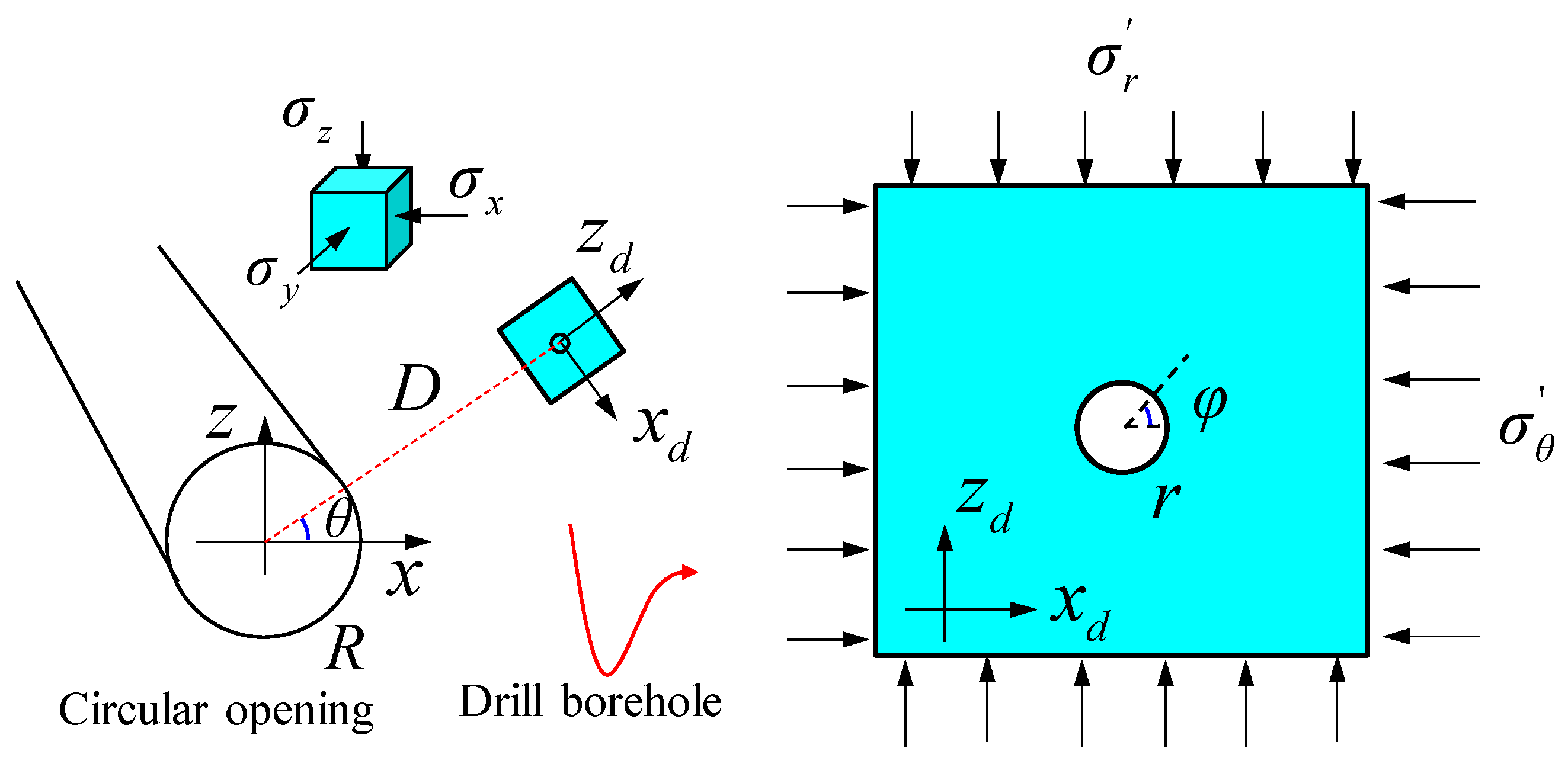
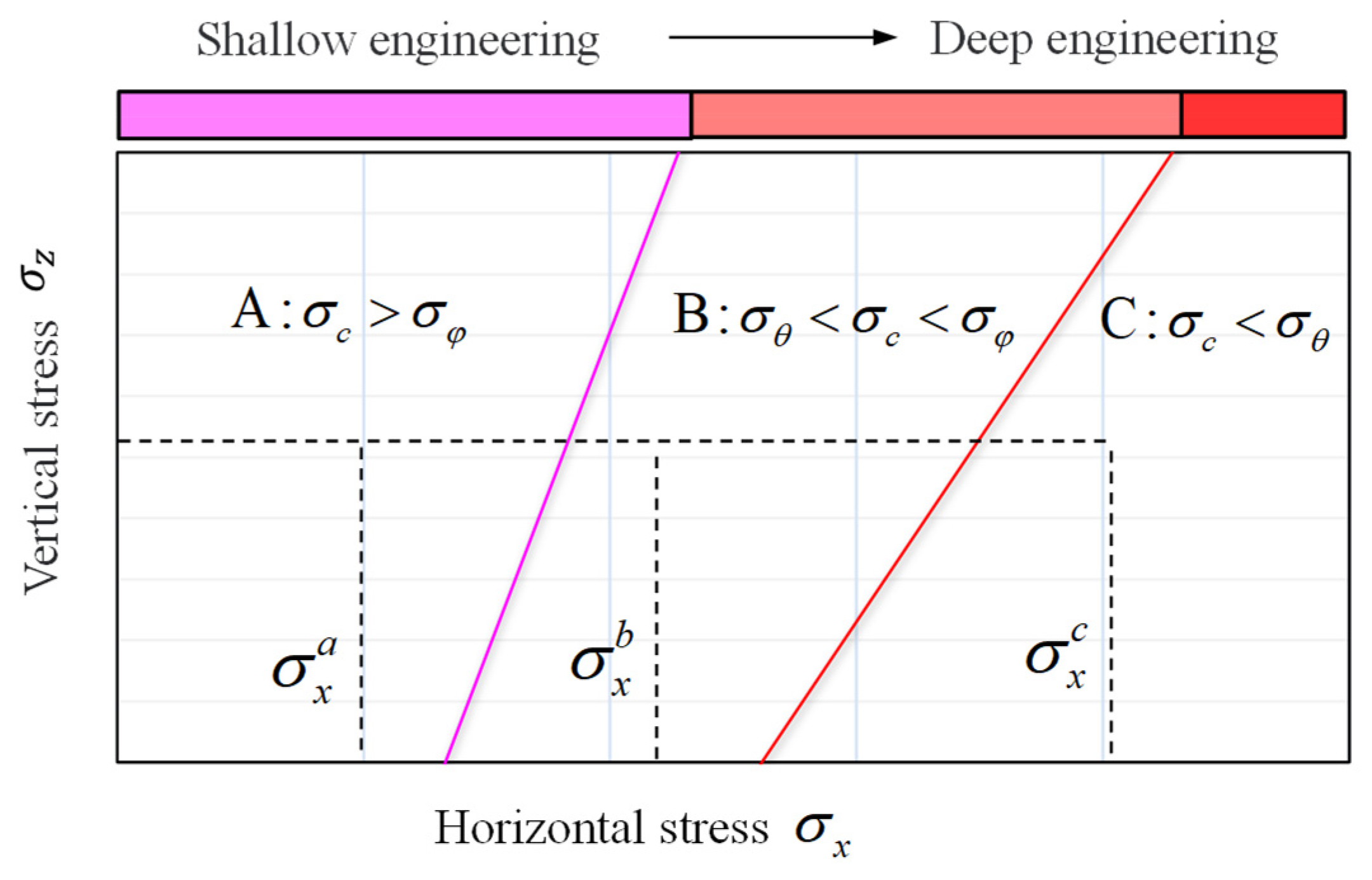
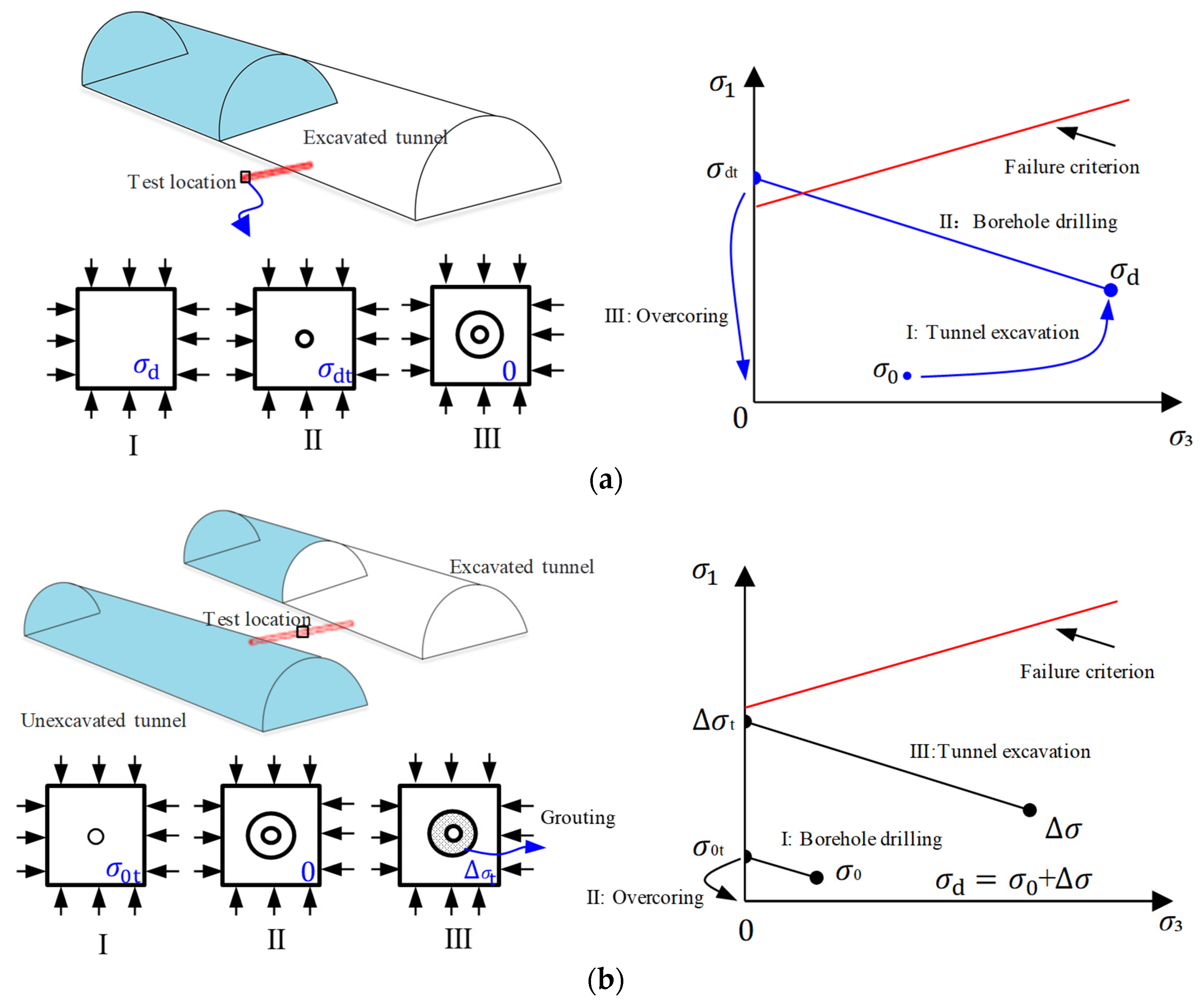

| k | 1 | 2 | 3 | 4 | 5 | 6 | 7 | 8 | 9 |
|---|---|---|---|---|---|---|---|---|---|
| θ | 90° | 90° | 90° | 210° | 210° | 210° | 330° | 330° | 330° |
| φ | 90° | 45° | 0° | 90° | 45° | 0° | 90° | 45° | 0° |
| Model | Cohesion /c (MPa) | Friction Angle /φ (deg) | Failure Depth under σ0/d1 (m) | Failure Depth under /d2 (m) | Failure Depth under /d3 (m) |
|---|---|---|---|---|---|
| 1 | 22 | 20 | 0.000 | 0.000 | 0.000 |
| 2 | 20 | 20 | 0.001 | 0.002 | 0.001 |
| 3 | 18 | 20 | 0.004 | 0.004 | 0.004 |
| 4 | 16 | 20 | 0.007 | 0.013 | 0.007 |
| 5 | 14 | 20 | 0.012 | 0.019 | 0.012 |
| 6 | 12 | 20 | 0.019 | 0.027 | 0.019 |
| 7 | 10 | 20 | 0.028 | 0.038 | 0.028 |
| 8 | 8 | 20 | 0.042 | 0.056 | 0.042 |
| 9 | 6 | 20 | 0.066 | 0.083 | 0.066 |
| 10 | 4 | 20 | 0.108 | 0.134 | 0.108 |
| 11 | 2 | 20 | 0.221 | 0.267 | 0.221 |
| 12 | 2 | 15 | 0.391 | 0.433 | 0.391 |
| 13 | 2 | 10 | 0.714 | 0.805 | 0.714 |
| Loading Case | Initial Stress | Disturbance Stress | Stress Zoning | ||||
|---|---|---|---|---|---|---|---|
| (MPa) | (MPa) | (MPa) | (MPa) | (MPa) | (MPa) | ||
| 1 | 10 | 10 | 10 | 20 | 20 | 20 | B |
| 2 | 20 | 10 | 10 | 30 | 20 | 20 | B |
| 3 | 20 | 20 | 10 | 30 | 30 | 20 | B |
| 4 | 20 | 20 | 20 | 30 | 30 | 30 | B |
| 5 | 30 | 10 | 10 | 40 | 20 | 20 | B |
| 6 | 30 | 20 | 10 | 40 | 30 | 20 | B |
| 7 | 30 | 20 | 20 | 40 | 30 | 30 | B |
| 8 | 30 | 30 | 10 | 40 | 40 | 20 | B |
| 9 | 30 | 30 | 20 | 40 | 40 | 30 | B |
| 10 | 30 | 30 | 30 | 40 | 40 | 40 | B |
| 11 | 40 | 10 | 10 | 50 | 20 | 20 | C |
| 12 | 40 | 20 | 10 | 50 | 30 | 20 | C |
| 13 | 40 | 20 | 20 | 50 | 30 | 30 | C |
| 14 | 40 | 30 | 10 | 50 | 40 | 20 | C |
| 15 | 40 | 30 | 20 | 50 | 40 | 30 | C |
| 16 | 40 | 30 | 30 | 50 | 40 | 40 | C |
| 17 | 40 | 40 | 10 | 50 | 50 | 20 | C |
| 18 | 40 | 40 | 20 | 50 | 50 | 30 | C |
| 19 | 40 | 40 | 30 | 50 | 50 | 40 | C |
| 20 | 40 | 40 | 40 | 50 | 50 | 50 | C |
| 21 | 50 | 10 | 10 | 60 | 20 | 20 | C |
| 22 | 50 | 20 | 10 | 60 | 30 | 20 | C |
| 23 | 50 | 20 | 20 | 60 | 30 | 30 | C |
| 24 | 50 | 30 | 10 | 60 | 40 | 20 | C |
| 25 | 50 | 30 | 20 | 60 | 40 | 30 | C |
| 26 | 50 | 30 | 30 | 60 | 40 | 40 | C |
| 27 | 50 | 40 | 10 | 60 | 50 | 20 | C |
| 28 | 50 | 40 | 20 | 60 | 50 | 30 | C |
| 29 | 50 | 40 | 30 | 60 | 50 | 40 | C |
| 30 | 50 | 40 | 40 | 60 | 50 | 50 | C |
| 31 | 50 | 50 | 10 | 60 | 60 | 20 | C |
| 32 | 50 | 50 | 20 | 60 | 60 | 30 | C |
| 33 | 50 | 50 | 30 | 60 | 60 | 40 | C |
| 34 | 50 | 50 | 40 | 60 | 60 | 50 | C |
| 35 | 50 | 50 | 50 | 60 | 60 | 60 | C |
Disclaimer/Publisher’s Note: The statements, opinions and data contained in all publications are solely those of the individual author(s) and contributor(s) and not of MDPI and/or the editor(s). MDPI and/or the editor(s) disclaim responsibility for any injury to people or property resulting from any ideas, methods, instructions or products referred to in the content. |
© 2024 by the authors. Licensee MDPI, Basel, Switzerland. This article is an open access article distributed under the terms and conditions of the Creative Commons Attribution (CC BY) license (https://creativecommons.org/licenses/by/4.0/).
Share and Cite
Zheng, M.; Li, S.; Lu, Y.; Lu, X.; Liu, L. The Performance Analysis of Grouting Repair Effect on the Accuracy of Disturbance Stress Test in Damaged Surrounding Rock Mass. Materials 2024, 17, 1926. https://doi.org/10.3390/ma17081926
Zheng M, Li S, Lu Y, Lu X, Liu L. The Performance Analysis of Grouting Repair Effect on the Accuracy of Disturbance Stress Test in Damaged Surrounding Rock Mass. Materials. 2024; 17(8):1926. https://doi.org/10.3390/ma17081926
Chicago/Turabian StyleZheng, Minzong, Shaojun Li, Yandu Lu, Xingan Lu, and Liu Liu. 2024. "The Performance Analysis of Grouting Repair Effect on the Accuracy of Disturbance Stress Test in Damaged Surrounding Rock Mass" Materials 17, no. 8: 1926. https://doi.org/10.3390/ma17081926





